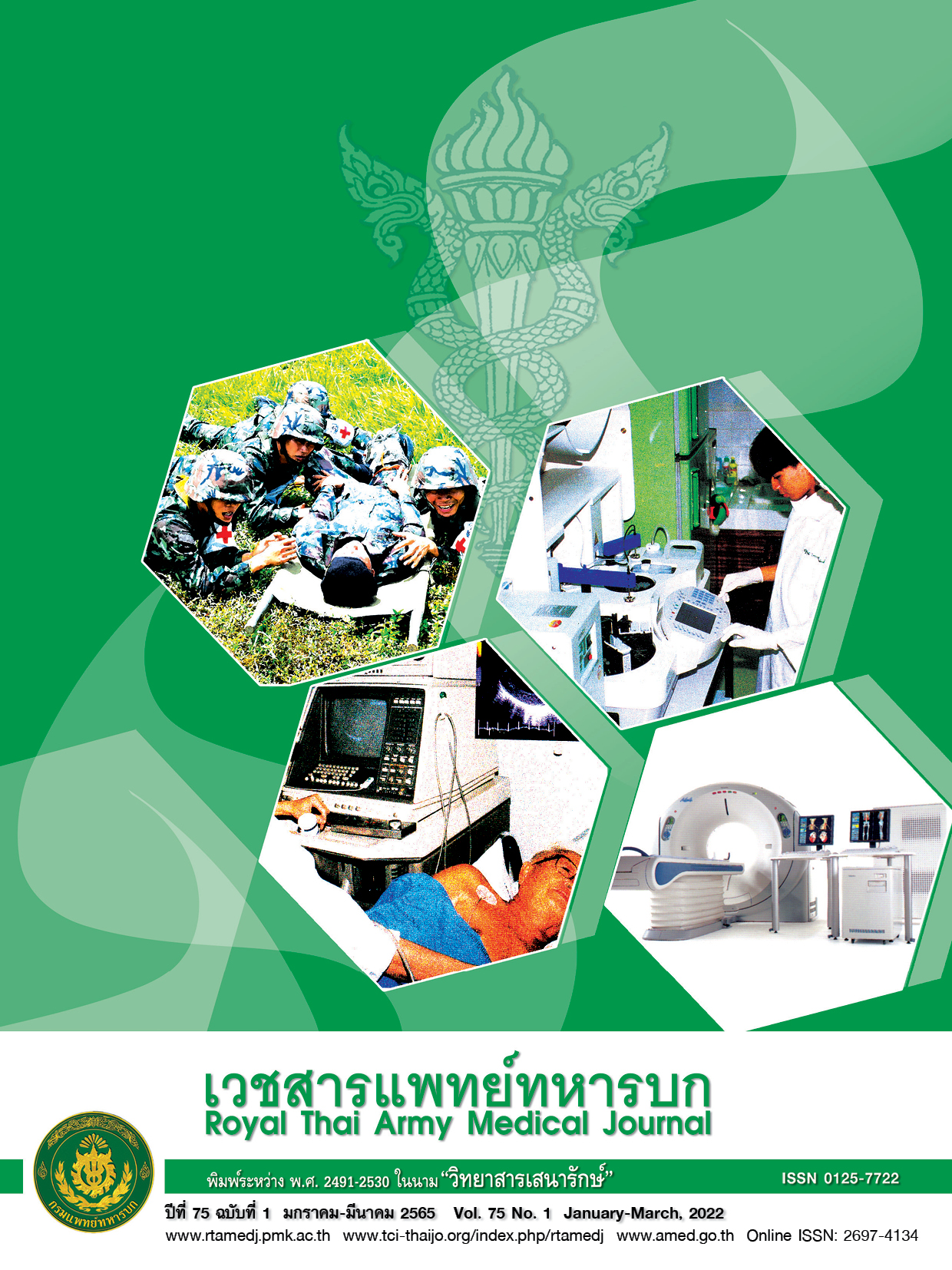ผลการใช้ submucosal CO2laser ในการรักษาโรคเยื่อบุโพรงอักเสบจากภูมิแพ้ ในโรงพยาบาลสมเด็จพระพุทธเลิศหล้า
Main Article Content
บทคัดย่อ
เยื่อบุโพรงจมูกอักเสบจากภูมิแพ้เป็นอาการที่พบได้บ่อยในเวชปฏิบัติโสต ศอ นาสิกวิทยา การหลีกเลี่ยงสิ่งที่แพ้เป็นวิธีการรักษาที่ดีที่สุด แต่ในความเป็นจริงนั้นทำได้ยาก วิวัฒนาการมีมากมายนับตั้งแต่การใช้ยาทาน ยาสเตียรอยด์(steroid) ชนิดพ่นจมูก และการผ่าตัดต่างๆ ในการรักษาโรคนี้ด้วย CO2laser ได้ถูกนำมาใช้ ที่ผ่านมาก็ยังไม่มีเกณฑ์ใดใช้เป็นวิธีมาตรฐานที่แน่นอน รายงานผลการศึกษาส่วนมากจะเป็นการใช้ CO2laser ยิงลงไปบนพื้นผิวเยื่อบุ(mucosa) ของ inferior turbinate ซึ่งทำให้เยื่อบุผิวไหม้และส่งผลให้แผลหายช้า ในการทำวิจัยครั้งนี้ใช้วิธีรักษาด้วย CO2laser ในชั้นใต้พื้นผิว (submucosa) เท่านั้น เพื่อทำให้เกิด submucosal fibrosis ซึ่งจะทำให้ปฏิกิริยาภูมิแพ้ต่อสารก่อภูมิแพ้ที่หายใจเข้าลดลงได้ และส่งผลกระทบต่อเซลล์ขนพัดโบกน้อย
วัตถุประสงค์ : เพื่อศึกษาประสิทธิภาพของ submucosal CO2laser ในการรักษาผู้ป่วยโรคเยื่อบุโพรงจมูกอักเสบจากภูมิแพ้ที่มีอาการตลอดปีในกลุ่มที่มีอาการน้อยไปจนถึงปานกลาง (mild to moderate symptoms) และทำการประเมินผลโดยการใช้ nasal symptom score
วิธีการศึกษา : เป็นการศึกษาแบบ Prospective randomized control trial โดยทำการเก็บข้อมูลจากผู้ป่วยเยื่อบุโพรงจมูกอักเสบจากภูมิแพ้ที่มีอาการตลอดปี ซึ่งมาตรวจที่แผนกผู้ป่วยนอกกลุ่มงานโสต ศอ นาสิกวิทยา โรงพยาบาลสมเด็จพระพุทธเลิศหล้า ตั้งแต่วันที่ 1 พฤศจิกายน พ.ศ. 2563 ถึง วันที่ 30 มิถุนายน พ.ศ. 2564จำนวน ทั้งสิ้น 42 คน แบ่งเป็นผู้ชาย 23 คนและผู้หญิง 19 คน แล้วทำการสุ่มผู้ป่วยเข้ารับการรักษาด้วย submucosal CO2 laser 21 คน โดยการใช้ซองสุ่มตัวอย่าง ส่วนอีก 21 คนเป็นกลุ่มผู้ป่วยที่ไม่ได้รับการรักษาด้วย submucosal CO2 laser ติดตามผลการรักษานาน 12 สัปดาห์
ผลการศึกษา : เมื่อทำการติดตามผลของการใช้ submusocal CO2laser ในการรักษาผู้ป่วยเยื่อบุโพรงจมูกอักเสบจากภูมิแพ้ที่มีอาการตลอดปีในกลุ่มที่มีอาการน้อยไปจนถึงปานกลาง จนถึงสัปดาห์ที่ 1, 3, 6 และ 12 พบว่า ได้ผลดีในแง่ของการลดอาการคัดจมูก,สารคัดหลั่งในจมูก,อาการคันและอาการจาม เมื่อเปรียบเทียบกับการรักษาในกลุ่มที่ไม่ได้ใช้ submucosal CO2laserอย่างมีนัยสำคัญทางสถิติ
สรุป : การใช้ submucosal CO2laser เป็นทางเลือกที่ดีวิธีหนึ่งในการรักษาผู้ป่วยเยื่อบุโพรงจมูกอักเสบจากภูมิแพ้ ที่มีอาการตลอดปีในกลุ่มที่มีอาการน้อยไปจนถึงปานกลาง และเป็นวิธีที่ทำง่ายผลข้างเคียงน้อย
Downloads
Article Details

อนุญาตภายใต้เงื่อนไข Creative Commons Attribution-NonCommercial-NoDerivatives 4.0 International License.
บทความในวารสารนี้อยู่ภายใต้ลิขสิทธิ์ของ กรมแพทย์ทหารบก และเผยแพร่ภายใต้สัญญาอนุญาต Creative Commons Attribution-NonCommercial-NoDerivatives 4.0 International (CC BY-NC-ND 4.0)
ท่านสามารถอ่านและใช้งานเพื่อวัตถุประสงค์ทางการศึกษา และทางวิชาการ เช่น การสอน การวิจัย หรือการอ้างอิง โดยต้องให้เครดิตอย่างเหมาะสมแก่ผู้เขียนและวารสาร
ห้ามใช้หรือแก้ไขบทความโดยไม่ได้รับอนุญาต
ข้อความที่ปรากฏในบทความเป็นความคิดเห็นของผู้เขียนเท่านั้น
ผู้เขียนเป็นผู้รับผิดชอบต่อเนื้อหาและความถูกต้องของบทความของตนอย่างเต็มที่
การนำบทความไปเผยแพร่ซ้ำในรูปแบบสาธารณะอื่นใด ต้องได้รับอนุญาตจากวารสาร
เอกสารอ้างอิง
1) Border I, Higgins MW, Mathew KP, Keller FB. Epidemiology of asthma and allergic rhinitis in a total community, Tecumseh, Michigan.II:Secon survey of community. J Allergy 1987; 53:127-138.
2) Bunnag C, Jareonsri P, Dhorranintra B, et al, A study of allergic incidence in Thais with middle ear disease. Asian Pac J Allergy Immunol 1992; 10(Suppl):FPE6.
3) Frankland AW, Augustin R.Prophylaxis of summer hay fever and astha ; a control trial comparing crude grass-pollen extracts with the isolated main protein component .Lancet 1954;I:1055-1057.
4) Lowell FC, Franklin W. A double-blind study of the effectiveness and specificity of injection therapy in ragweed hay fever. N EngI J Med 1965;273:675-679.
5) Juniper E. Impact of upper respiratory allergic diseases on quality of life. J Allergy Clin Immunol. 1998;101(2 Pt 2):S386-S391.
6) Caffier PP, Frieler K, Scherer H, Sedlmaier B, Goktas O. Rhinitis medicamentosa: therapeutic effect of diode laser inferior turbinate reduction on nasal obstruction and decongestant abuse. Am J Rhinol. 2008 Jul-Aug;22(4):433-9. [PubMed | DOI]
7) Ass K. Desensitization in house dust allergy asthma: a double blind controlled study with evaluation of the effect on bronchial sensitivity to house dust. Acta Paediatr1971; 60:264-268.
8) Nelson BL,Dupont LA,Reid MJ Prospective survey of local and systemic reaction to immunotherapy with pollen extracts. Ann Allergy 1986; 56:331-334.
9) Greenberg MA, Kaufman CR, Gonzalez GE, et,al Late and immediated systemic reactions to inhalant immunotherapy. J Allergy Clin Immunol 1986; 77:865-870.
10) Siefert G. Side effect in hyposensitization. Causality prospects in future. Allergol Immunopathol (Mardr) 1990; 13:150-155.
11) Mittelman H. CO2-laser turbinectomies for chronic obstructive rhinitis. Lasers Surg Med. 1982;2(1):29-36.
12) Courtiss EH. Goldwyn RM, O’ Brian J. Resection of obstructing inferior nasal turbinates, Plast Reconstr Surg 1978; 62:249-257.
13) Moore GF, Freeman TJ, Ogren FP, Youkers A. Extended follow up of total inferior turbinate resection for relief of chronic nasal obstruction. Laryngoscope 1985; 1095-1099.
14) Mabry RL. Inferior Turbinoplasty . Otolaryngol Head and Neck Surg 1991; 2:183-188.
15) Okuda M. Fundamental and clinical studies on nasal allergy. Otologia Fukuoka 1974; 20:297-344.
16) House HP. Submucasal reaction of the inferior turbinal bone. Laryngoscope 1951; 61:637-648.
17) Principato JJ Chronic vasomotor rhinitis: cryogenic and other surgical modes of treatment. Laryngoscope 1979; 89:619-638.
18) Simmons MW. Intranasal injection of corticosteroids in nasal disorders: further observations. Trana Pac Coast Otol Opthalmol Soc 1964; 45:95-103.
19) Talaat M, el-Sabawy E, Baky FA, Raheem AA. Submucus diathermy of the inferior turbinates in chronic hypertrophic rhinits.
20) Principato JJ. Chronic vasomotor rhinitis: cryogenic and other surgical modes of treatment. Laryngoscope. 1979;89(4):619-638. J Laryngol Otol. 1987;101(5):452-460.
21) Seikin S. Laser Turbinectomy as an adjunct to rhinoseptoplasty . Arch Otolaryngol Head and Neck Surg 1985; 111:446-449.
22) Tsai YL, Chang CC ,et,al .Outcome survey of therapy with diode laser in patients with allergic rhinitis , Department of Otolaryngology, Head and Neck Surgery , Changhua christia, Taiwan 2005; Feb 34:38-40.
23) Somyos Kunachak, MD, Boonchu Kulapaditharum, MD, and Supawadee Prakunhungsit, MD. Minimally invasive KTP laser treatment of perennial allergic rhinitis: A preliminary report . Otolaryngology, vol.29, Nov.3; 2000.
24) Jiro Nishimoto, Hirobumi Kumazawa , et al. Effect of DIODE laser on mucosal swelling of outpatient with perennial allergic rhinitis. Otorhinolaryngologia, vol.9, no.3; 1999.
25) Chalermchai Chintrakarn, Narista Pittayaradchasak. Diode laser treatment of perennial allergic rhinitis. Thai J.Otolaryngogy/Head Neck Surg.2006; 7:37-44.
26) Sroka R, Janda P, Killian T, Vaz F, Betz CS, Leunig A. Comparison of long term results after Ho: YAG and diode laser treatment of hyperplastic inferior nasal turbinates. Lasers Surg Med. 2007; 39(4):324-331.
27) Lenders H, Pirsig W. Diganostic value of acoustic rhinometry: patients with allergic and vasomotor rhinitis compared with normal controls. Rhinology. 1990;28(1):5-16.
28) Lenz H. Eight years’ laser surgery of the inferior turbinates in vasomotor rhinopathy in the form of laser strip carbonization. HNO1958; 33: 422- 425.
29) Fukutake T, YamashitaT, Tomoda K, Kumazawa T, Laser surgery for allergic rhinitis. Arch Otolaryngol Head Neck Surg 1986; 112: 1280-1282.
30) Kawamura S, Fukutake T, Kubo N, et al. Subjective results of laser surgery for allergic rhinitis. Acta Otolaryngol (Stockh) 1993; Suppl 500: 109-112.
31) Levine HL. The potassium- titanyl phosphate laser treatment of turbinate dysfunction. Otolaryngol Head Neck Surg 1991; 104: 247-251.
32) Pakpoom Supiyaphun,Phooripan Aramwatanapong,Virachai Kerekhanjanarong,Veerapong Sastarasadhit. KTP laser inferior turbinoplasty:an alternative procedure to treat the nasal obstruction.Auris Nasus Larynx ,vol.30(2003)59-64.


